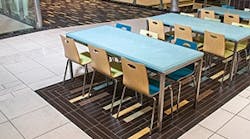Slip and fall accidents by customers, employees and pedestrians are a nightmare every commercial building owner and facility manager wants to prevent. With 85 percent of workers’ compensation claims attributed to slip and fall accidents on slick floors1 and flooring materials contributing to more than 2 million fall injuries per year2, there’s real cause for care when it comes to specifying the right flooring and the possible liability associated with getting it wrong.
With this in mind, we worked with the Tile Council of North America (TCNA) to develop the following FAQ about the coming changes to the testing and reporting of coefficient of friction (COF) values for ceramic tile, and how they might affect designers’ own legal liabilities in slip and fall cases. Note that this information is provided only for guidance/informational purposes, and is not offered nor meant to be taken as legal advice.
what is cof and how does it affect the legal liabilities of interior designers?
When we think about tile, there are physical properties that are the same, regardless of who makes the measurement or how it’s being measured. Size and weight are fixed physical properties, but coefficient of friction (COF) is a relationship. The COF of a tile is different for every consumer who walks on that tile, because coefficient of friction is the relationship between what’s on the bottom of a customer’s shoe and the surface of a tile. The surface remains the same, but the frictional requirements are different
depending on the speed the person is walking, whether there are contaminants on the floor, and the surface on the bottom of their shoes.
Until the American National Standards Institute (ANSI) A137.1 standard for ceramic tile, approved in 2012, there were no rules requiring a minimum COF value for tile flooring. Many designers cite a 0.6 static coefficient of friction (SCOF) value as a requirement of the Americans with Disabilities Act, but in fact, that value was recommended by the Access Board and was never a requirement of the act itself.
The new ANSI standard sets a minimum dynamic coefficient of friction (DCOF) rating of 0.42, as measured by the new DCOF AcuTestSM in a laboratory, for level interior floors expected to be walked on when wet.
how does the change in cof testing affect a designer’s liability when it comes to specifying floor tile?
One of the things that’s relevant when discussing legal liability is the question of what is a reasonable expectation? It’s a reasonable expectation that if the standard for ceramic tiles says a tile that has a DCOF AcuTest value of less than 0.42 should not be used in a wet area, the designer should be cognizant of the standard and make sure they are specifying a tile with the proper DCOF value. If a designer ends up in court due to a slip and fall claim, it will be hard to argue that he or she wasn’t aware of the requirement when the ANSI standard clearly references the 0.42 DCOF value.
In the event that a client requests floor tiles with a DCOF value of less than 0.42, it is recommended that the designer secure documentation indicating that the client has been informed, per the ANSI standard, that the tile is not recommended unless it will be walked on only when dry. PageBreak
can designers still use tiles that don’t meet the 0.42 dcof standard with the proper research and intent?
There are plenty of lobbies that use polished surfaces, and polished surfaces can have very good traction when dry. The key to preventing liability issues in these spaces is to ensure that the owner of the building acknowledges that they have been made aware of what the standard says, and that they have elected to use these surfaces because it is their intent to keep them dry when people are walking on them.
will tiles that were tested to the previous
0.6 scof recommendation comply with the new dcof requirements? will designers who have specified tile to the 0.6 scof recommendation in the past be subject to additional liabilities?
Without getting into complex legal issues relating to what was the standard of care or reasonable expectations at the time the floor was installed, in general, tiles that complied with the 0.6 SCOF value in the past likely comply with the current 0.42 DCOF AcuTest criteria. That said, prudent facility
owners may want to verify the DCOF of their floors and periodically monitor the values as a check on their maintenance procedures.
the ansi standard cautions that frequently wet or otherwise slippery installations require “extra caution in product selection,
use and maintenance.” what does a designer need to keep in mind when
specifying tile flooring in especially demanding environments?
If a designer identifies an atypical area of use—for example, an area that is wetter than one might commonly expect, will have children running on it or disabled individuals walking on it—there’s a possibility of a lower level of traction between the floor and the individual, and a higher incidence of slips.
The ANSI standard is clear in saying that there are many more issues that go into the selection of flooring than a single COF value, and designers specifying flooring for an environment like this will likely need to consider multiple variables, including:
- the likely contaminants on the floor;
- the activities that people will be engaging in on its surface
- the likelihood of people seeing contaminants
- and lighting levels in the space.
Unfortunately, there are no hard numbers to guide specifiers in these situations, but a reasonable analysis of the environment coupled with the use of tile meeting or exceeding the standard’s DCOF minimum guidelines will help reduce the chance of injury and minimize a designer’s liability.
It’s also worth noting that part of the conversation with the client should be how the floor is maintained. Keeping it clean and the surface in usable condition is an important part of the safety that the consumer is expecting.
how can increased attention to
dcof values help protect a client’s
bottom line?
By educating clients on the new DCOF requirements, designers can protect both users and business owners. As an example, the TCNA is aware of a large property group that began a
program of regularly checking the DCOF value of all the flooring surfaces in its properties. Any surface
that did not exceed this criterion was either enhanced through various traction-enhancing treatments or replaced; in some cases, they also selected different cleaning chemicals or implemented new cleaning procedures. The group similarly held the maintenance company responsible for ensuring that surfaces remained clean and safe, instructing them to keep all flooring surfaces over the DCOF AcuTest value of 0.42.
According to the TCNA, this company went from more than 1,000 slip and fall-related cases a year to zero. Furthermore, because the company had documentation that showed how the traction of the floors was being maintained, the few suits that were alleged were dropped before going to court.
REFERENCES:
1 Occupational Health & Safety Administration,
www.osha.gov
2 Consumer Product Safety Commission, www.cspc.gov


